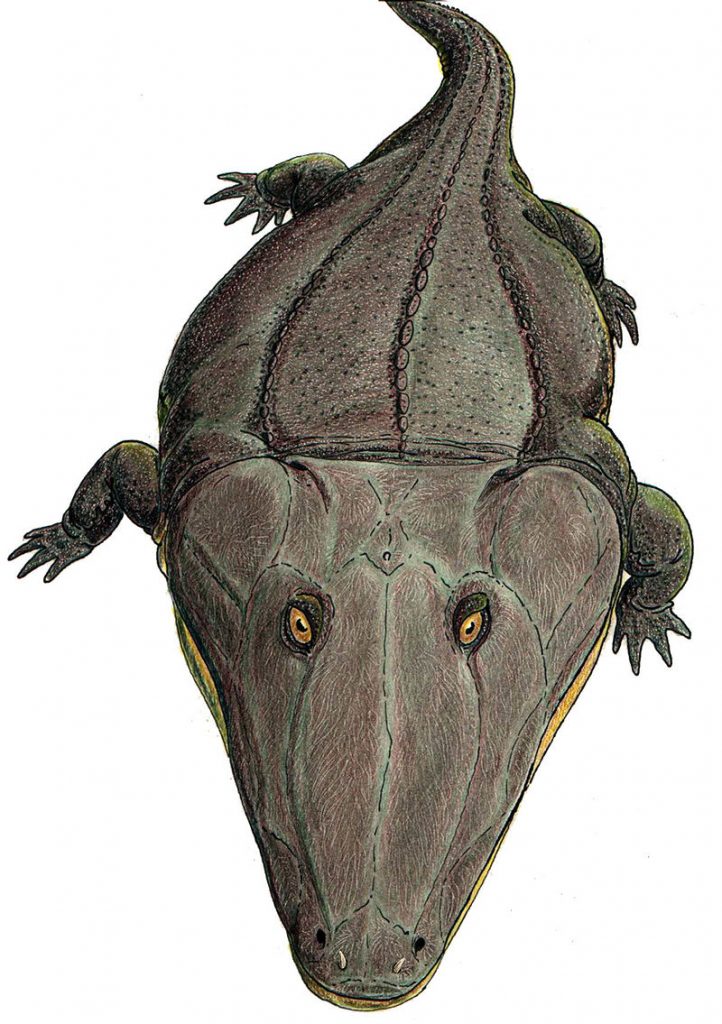Mastodonsaurus

The enormous head of this massive amphibian is nearly all mouth. Two eyes sit atop its head, and its raised nostrils give it a somewhat crocodilian appearance. Its body is long and flat.
Originally Posted by Shade of the En World forums.
Mastodonsaurus is a larger relative of eryops. It spends all its time in the water, and is nearly helpless on land.
A mastodonsaurus is 12 to 15 feet long, weighing 800 to 1,000 pounds.
These statistics can be used to represent other large temnospondyls, such as cyclotosaurus, cherninia, and siderops.
| Mastodonsaurus | |
| Large animal (Aquatic) | |
| Hit Dice | 5d8+35 (57 hp) |
| Initiative | +0 |
| Speed | 5 ft. (1 square), Swim 70 ft. |
| Armor Class | 14 (-1 size, +5 natural), touch 9, flat-footed 14 |
| Base Attack/Grapple | +3/+15 |
| Attack | Bite +10 melee (2d8+12) |
| Full Attack | Bite +10 melee (2d8+12) |
| Space/Reach | 10 ft./5 ft. |
| Special Attacks | Improved grab, swallow whole, vortex maw |
| Special Qualities | Low-Light Vision, water dependent |
| Saves | Fort +8, Ref +3, Will +1 |
| Abilities | Strength 27, Dexterity 10, Constitution 25, Intelligence 1, Wisdom 11, Charisma 5 |
| Skills | Hide +6*, Listen +3, Move Silently +4, Spot +3, Swim +15 |
| Feats | Alertness, Stealthy |
| Environment | Warm marshes |
| Organization | Solitary |
| Challenge Rating | 4 |
| Treasure | None |
| Alignment | Always neutral |
| Advancement | 6-9 HD (Large), 11-15 HD (Huge) |
| Level Adjustment | – |
COMBAT
Like a crocodile, a mastodonsaurus often hides the bulk of its body underwater, with only its eyes and nostrils breaking the surface. It sucks fish and other small prey into its huge mouth, swallowing them whole.
Improved Grab (Ex): To use this ability, a mastodonsaurus must hit an opponent of up to one size smaller with its bite attack. It can then attempt to start a grapple as a free action without provoking an attack of opportunity. If it wins the grapple check, it establishes a hold and can try to swallow the foe the following round.
Swallow Whole (Ex): A mastodonsaurus can try to swallow a grabbed opponent of up to two sizes smaller by making a successful grapple check. The swallowed creature takes 2d8+8 points of bludgeoning damage and 1d6 points of acid damage per round from the gizzard. A swallowed creature can cut its way out by using a light slashing or piercing weapon to deal 15 points of damage to the gizzard (AC 12). Once the creature exits, muscular action closes the hole; another swallowed opponent must cut its own way out.
A Large mastodonsaurus’s gizzard can hold 2 Small, 8 Tiny, or 16 Diminutive or smaller opponents.
Vortex Maw (Ex): A mastodonsaurus can open its mouth so quickly that it creates a powerful suction. All creatures within a 15-foot cone must make Strength checks opposed by the mastodonsaurus’s Strength check (+8 for a standard mastodonsaurus), with the same modifiers as a bull rush. If the mastodonsaurus beats a creature’s Strength check result, it pulls the victim 5 feet closer to its jaws. For each 5 points by which its check result is greater than a victim’s check result, the mastodonsaurus pulls the victim an additional 5 feet closer. The victim provokes attacks of opportunity if it is moved.
Water Dependent (Ex): A mastodonsaurus can survive out of the water for 1 hour per 2 points of Constitution (after that, refer to the drowning rules on page 304 of the Dungeon Master’s Guide).
Skills: A mastodonsaurus has a +8 racial bonus on any Swim check to perform a special action or avoid a hazard. It can always choose to take 10 on a Swim check, even if distracted or endangered. It can use the run action while swimming, provided it swims in a straight line.
*A mastodonsaurus gains a +4 racial bonus on Hide checks when in the water. Further, a mastodonsaurus can lie in the water with only its eyes and nostrils showing, gaining a +10 cover bonus on Hide checks.
Originally apperead in Dragon Magazine #112 (1986) as “Labrynthodont”.

 Buy me a coffee
Buy me a coffee